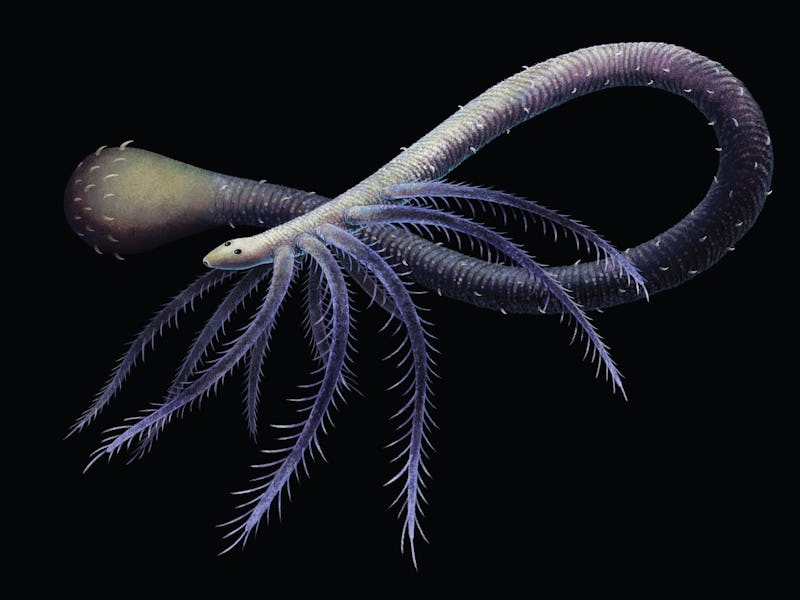A twist of fate saved humans from sharing Earth with terrifying, limbed worms
Thank you, evolution.

Some 518 million years ago, Earth's oceans were home to a terrifying creature: a worm-like animal with a long, serpentine body and a set of spiky legs situated close to its head.
But this worm is more than weird: A new study reveals that it made an evolutionary leap unlike any other before it — it lost its limbs.
Scientists have long believed that the strange Facivermis held the key to an evolutionary step in worm families. It was thought to be the 'missing link' species in between lobopodians, worms with limbs along their bodies, and the cycloneuralian worms, which look like worms as we know them.
“This is the earliest example in the fossil record of an organism undergoing 'secondary reduction.'"
In a study published Thursday in Current Biology, researchers describe how the worm shed some of its legs as it evolved.
Facivermis lived on the seafloor, and down there, those spindly protuberances weren’t of much use to it. Instead, it evolved to look more like a tube than a crawler.
“Our findings show Facivermis had lost its back legs and become worm-like to suit its tube-dwelling lifestyle, think of a modern tube worm,” Xiaoya Ma researcher from the Natural History Museum tells Inverse. “Whereas previously its 'worminess' had been seen as a primitive feature.”
This is the earliest known creature to lose body parts in order to evolve. Facivermis is from the Cambrian period, a time on Earth known as the dawn of animal life, so it is surprising that the worm evolved in such a specialist way.
“This is the earliest example in the fossil record of an organism undergoing 'secondary reduction,' losing derived body parts it no longer needed, like the loss of limbs in snakes and lizards today for example,” Ma says.
“We are talking about an animal 518 million years old, right at the beginning of complex animal ecosystems," she says.
"It is easy to think of animals evolving to be more complex over time, but of course Facivermis shows us this isn't always the case!”
Mystery has long surrounded the evolution of Facivermis, a worm-like creature that lived approximately 518 million years ago in the Cambrian period.
Where did their legs go?
It was all in the butt, the researchers discovered.
Most of Facivermis' wormy relatives had three to nine sets of lower legs, but the Facivermis’ end was a little different. Instead, it was surrounded by a tube, and had a swollen ball-like butt that it used to anchor itself into the sand. As a result, the worm's small, lower legs were not of any use to it, as it stuck in place and used its top legs to filter food from the water.
“Facivermis is a fossil species we have known for over 30 years, but new specimens have allowed us to classify it more confidently with the lobopodians, and have given us an explanation for its worm-like unusual morphology," Ma says.
The findings contradict past studies which suggest the Facivermis was a basal, worm-like panarthropod from the start. Instead, the new research concludes, it was a legged creature at at least one point in its history.
“It means we are back to square one regarding the common ancestor of lobopodians and cycloneuralians,” Ma says.
“We simply have no candidate fossil now that it's clear Facivermis doesn't fit this description.”
More work is needed to fully understand the morphology and evolutionary relationship of members this group of animals, Ma says. But in the meantime, we humans can be thankful that Facivermis paved the way for the worms we know today. Ugly as they may be, at least they don't also have legs.
Abstract: Facivermis yunnanicus [1, 2] is an enigmatic worm-like animal from the early Cambrian Chengjiang Biota of Yunnan Province, China. It is a small (<10 cm) bilaterian with five pairs of spiny anterior arms, an elongated body, and a swollen posterior end. The unusual morphology of Facivermis has prompted a history of diverse taxonomic interpretations, including among annelids [1, 3], lophophorates [4], and pentastomids [5]. However, in other studies, Facivermis is considered to be more similar to lobopodians [2, 6, 7, 8]—the fossil grade from which modern panarthropods (arthropods, onychophorans, and tardigrades) are derived. In these studies, Facivermis is thought to be intermediate between cycloneuralian worms and lobopodians. Facivermis has therefore been suggested to represent an early endobenthic-epibenthic panarthropod transition [6] and to provide crucial insights into the origin of paired appendages [2]. However, the systematic affinity of Facivermis was poorly supported in a previous phylogeny [6], partially due to incomplete understanding of its morphology. Therefore, the evolutionary significance of Facivermis remains unresolved. In this study, we re-examine Facivermis from new material and the holotype, leading to the discovery of several new morphological features, such as paired eyes on the head and a dwelling tube. Comprehensive phylogenetic analyses using parsimony, Bayesian inference, and maximum likelihood all support Facivermis as a luolishaniid in a derived position within the onychophoran stem group rather than as a basal panarthropod. In contrast to previous studies, we therefore conclude that Facivermis provides a rare early Cambrian example of secondary loss to accommodate a highly specialized tube-dwelling lifestyle.